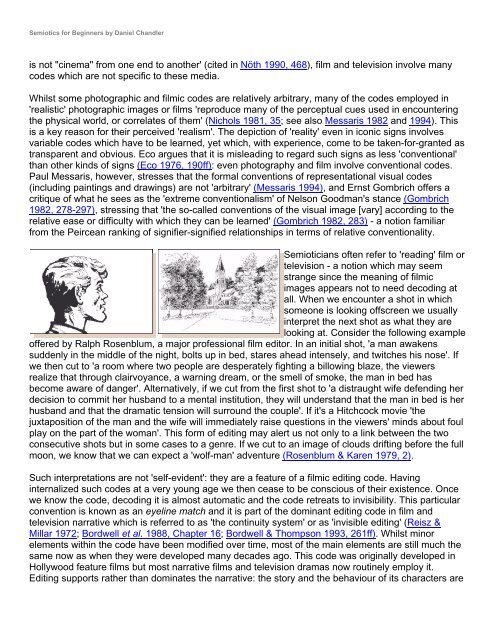Semiotics for Beginners by Daniel Chandler
Semiotics for Beginners by Daniel Chandler
Semiotics for Beginners by Daniel Chandler
Create successful ePaper yourself
Turn your PDF publications into a flip-book with our unique Google optimized e-Paper software.
<strong>Semiotics</strong> <strong>for</strong> <strong>Beginners</strong> <strong>by</strong> <strong>Daniel</strong> <strong>Chandler</strong><br />
is not "cinema" from one end to another' (cited in Nöth 1990, 468), film and television involve many<br />
codes which are not specific to these media.<br />
Whilst some photographic and filmic codes are relatively arbitrary, many of the codes employed in<br />
'realistic' photographic images or films 'reproduce many of the perceptual cues used in encountering<br />
the physical world, or correlates of them' (Nichols 1981, 35; see also Messaris 1982 and 1994). This<br />
is a key reason <strong>for</strong> their perceived 'realism'. The depiction of 'reality' even in iconic signs involves<br />
variable codes which have to be learned, yet which, with experience, come to be taken-<strong>for</strong>-granted as<br />
transparent and obvious. Eco argues that it is misleading to regard such signs as less 'conventional'<br />
than other kinds of signs (Eco 1976, 190ff): even photography and film involve conventional codes.<br />
Paul Messaris, however, stresses that the <strong>for</strong>mal conventions of representational visual codes<br />
(including paintings and drawings) are not 'arbitrary' (Messaris 1994), and Ernst Gombrich offers a<br />
critique of what he sees as the 'extreme conventionalism' of Nelson Goodman's stance (Gombrich<br />
1982, 278-297), stressing that 'the so-called conventions of the visual image [vary] according to the<br />
relative ease or difficulty with which they can be learned' (Gombrich 1982, 283) - a notion familiar<br />
from the Peircean ranking of signifier-signified relationships in terms of relative conventionality.<br />
Semioticians often refer to 'reading' film or<br />
television - a notion which may seem<br />
strange since the meaning of filmic<br />
images appears not to need decoding at<br />
all. When we encounter a shot in which<br />
someone is looking offscreen we usually<br />
interpret the next shot as what they are<br />
looking at. Consider the following example<br />
offered <strong>by</strong> Ralph Rosenblum, a major professional film editor. In an initial shot, 'a man awakens<br />
suddenly in the middle of the night, bolts up in bed, stares ahead intensely, and twitches his nose'. If<br />
we then cut to 'a room where two people are desperately fighting a billowing blaze, the viewers<br />
realize that through clairvoyance, a warning dream, or the smell of smoke, the man in bed has<br />
become aware of danger'. Alternatively, if we cut from the first shot to 'a distraught wife defending her<br />
decision to commit her husband to a mental institution, they will understand that the man in bed is her<br />
husband and that the dramatic tension will surround the couple'. If it's a Hitchcock movie 'the<br />
juxtaposition of the man and the wife will immediately raise questions in the viewers' minds about foul<br />
play on the part of the woman'. This <strong>for</strong>m of editing may alert us not only to a link between the two<br />
consecutive shots but in some cases to a genre. If we cut to an image of clouds drifting be<strong>for</strong>e the full<br />
moon, we know that we can expect a 'wolf-man' adventure (Rosenblum & Karen 1979, 2).<br />
Such interpretations are not 'self-evident': they are a feature of a filmic editing code. Having<br />
internalized such codes at a very young age we then cease to be conscious of their existence. Once<br />
we know the code, decoding it is almost automatic and the code retreats to invisibility. This particular<br />
convention is known as an eyeline match and it is part of the dominant editing code in film and<br />
television narrative which is referred to as 'the continuity system' or as 'invisible editing' (Reisz &<br />
Millar 1972; Bordwell et al. 1988, Chapter 16; Bordwell & Thompson 1993, 261ff). Whilst minor<br />
elements within the code have been modified over time, most of the main elements are still much the<br />
same now as when they were developed many decades ago. This code was originally developed in<br />
Hollywood feature films but most narrative films and television dramas now routinely employ it.<br />
Editing supports rather than dominates the narrative: the story and the behaviour of its characters are




